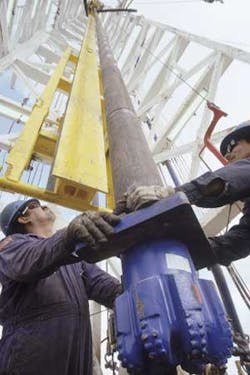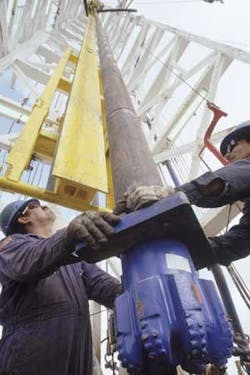MonoDiameter technology keeps hole diameter to TD
Jennifer Pallanich Hull
Gulf of Mexico Editor
Shell and Enventure's MonoDiameter technology drew some inspiration from pipelines when it looked for a way to move beyond the limitations imposed on drilling by the telescoping effect.
The companies unveiled their MonoDiameter technology in September, following a successful onshore trial and with a pending Gulf of Mexico application.
While the industry tends to focus on the ability to go deeper, Shell Exploration & Production Co. (Sepco) President and CEO Raoul Restucci said MonoDiameter technology will steer focus back to reaching total depth, not just vertically but also in extended reach wells.
"Extended well reach is going to be totally redefined," he said.
The MonoDiameter technology eliminates the telescoping effect caused by running casing, creating a wellbore that reaches total depth (TD) with the same internal diameter as when the well spudded at the seabed. The technology was commercialized by a joint effort between Shell International E&P Inc., Shell Technology Ventures and Halliburton Energy Service in the form of Enventure Global Technology, a joint venture between Shell Technology and Hallibur-ton Energy Ventures, founded in December 1998.
MonoDiameter debuted at one of Shell's onshore well locations in south Texas in May. The well tested a 11 3/4-in. x 14 1/2-in. solid expandable tubular (SET) system, two sections of two-trip 9 5/8-in. MonoDiameter expandables, and a 7 5/8-in. x 9 5/8-in. expandable openhole liner through a window. The gas well field test, a collaborative effort by Sepco, SIEP, and Enventure, is onstream. The original goal was to have MonoDiameter technology available by 2007, said John Darley, director of Shell Technology E&P.
Because of the success onshore, Restucci said, Sepco expects to apply the technology in the Gulf next year. The company considers three locations in the GoM as potential contenders for the first offshore MonoDiameter use, he said.
Sepco plans to use existing rigs under current contracts during the first round of offshore MonoDiameter wells, he said.
Breaking barriers
MonoDiameter technology can make a well with the same internal casing diameter from surface to total depth, eliminating the telescoping as additional casing is added.
"I always took this as a given," said Enven-ture Global Technology President and CEO Lance Cook, pointing at a graphic depicting the telescoping phenomenon.
He asked why the pipeline side of an operating company can start out with a 20-in. pipe in Houston and wind up with a 20-in. pipe in New York, 1,500 mi later, when the drilling side of the company cannot start with a 20-in. hole at the seabed and end with a 20-in. hole deep at TD.
"It's a simple concept, a simple realization that this was a barrier," he said. "That barrier has fallen."
Restucci sees MonoDiameter as achieving common use within five to seven years, although the technology will not likely be used on all offshore wells.
In the early part of the life cycle, the cost of the MonoDiameter well may not justify converting from the traditional telescoping well design in low cost areas, such as shallow onshore wells. As the quantity of MonoDia-meter equipment manufactured increases, the cost of the equipment will drop, making it a more economical choice. Cook believes this will lead to most wells being MonoDiameter.
The path to acceptance will likely be lined with hybrid combinations as operators gain confidence in the technology, Restucci said.
"I'm not worried because the size of the prize is so large," he said.
A hybrid well is one that features conventinal casing for the first three or four strings and then moves to a series of MonoDiameter liners. Cook said he sees this as the first step in deepwater, where the customer might run, for example, 36-in., 20-in., 13 3/8-in., 11 3/4-in., 9 5/8-in. MonoDiameter, 9 5/8-in. MonoDia-meter, 9 5/8-in. MonoDiameter, and so on, until the objective is reached. This well design could become standard for deepwater, where, say, only two 9 5/8-in. MonoDia-meter liners could be run on a 16,000-ft well, or eight could be run for a 35,000-ft well, Cook said.
The technology
Shell expects the MonoDiameter system to be particularly useful in deepwater, in subsalt zones, and for deep wells where unexpected challenges may be encountered before reaching the desired target depth.
"This technology allows the industry to drill deeper than ever before and reach previously unattainable geological objectives," Darley said.
To date, Cook said, the deepest well drilled is 9 1/2 mi (54,720 ft).
Using MonoDiameter tubulars, which allow operators to slim down the top of the well while increasing the well diameter at TD, creates a "big straw" through which to pull hydrocarbons out of the ground. This means that regardless of unexpected problems, each well drilled has the potential to reach its reservoir with a casing size that will enable reservoirs to produce at full potential. The higher prod-uction levels mean fewer wells required to recover the same amount of hydrocarbons by allowing operators to flow wells at maximum rates and drill multiple wells from a common platform.
The consequences of MonoDiameter technology could be further reaching than horizontal drilling, Restucci said.
SET technology (Offshore, July 2002) enables operators to drill through high-pressure zones and subsalt plays where unexpected loss-of-returns prevents adequate well control without setting additional casing strings, the companies said.
Reservoirs previously considered uneconomical or impossible to reach with traditional casing technology can be drilled with MonoDiameter technology.
"You have an infinite number of options," Cook said of well planning with MonoDiameter capabilities.
MonoDiameter well designs can facilitate well evaluation by providing larger diameter casing deeper in the well, allowing operators to continue use of conventional logging tools, Shell said.
SETs are made of standard tubular steel with increased ductility, reduced defect sensitivity, and increased fracture toughness. The proprietary process that treats the steel allows the steel pipe to be permanently deformed in the well bore, analogous to performing the final manufacturing process of the tubular downhole.
Cost savings
An operator drilling in ultra-deepwater with a fifth- or sixth-generation semisubmersible could spend up to $400,000 per day in spread costs. The MonoDiameter system translates to a smaller riser and BOP stack. Less deck space is required to store the riser and BOP stack. Shell said the weight and space saved by downsizing equipment requirements would allow operators to use a third-generation unit, halving drilling spread rates.
If the industry embraces use of MonoDiameter technology, there could be standardization of equipment and downhole tubulars, Shell says, which could mean a significant reduction in the cost of drilling a well.
Restucci cited potential reductions as up to a 75% drop in footprint, a 20% decrease in drilling flluids, 50% fewer drill cuttings and cement, and a 55% reduction in steel, in addition to the projected 40% savings in rig cost.
"It's not just the rig rates," he said. "It's the consumables."


